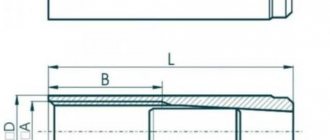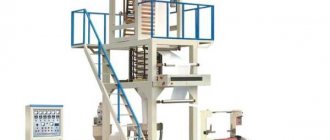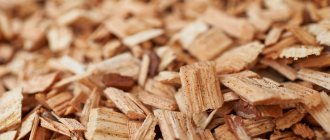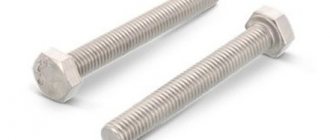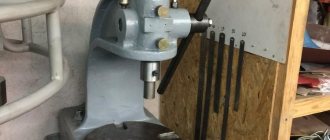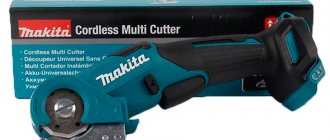The 2022 State Standard P 57787 provides a very short definition of a drive-in type anchor. The wording sounds like this: this is a hardware that must be installed in the design position by hammering its entire or component part into the base. As they say, neither add nor subtract. However, in reality everything is not so simple. In fact, the driven anchor (another common name is the collet anchor) has features of both design and application. Let's look at these questions in more detail.
Structure of a drive-in anchor
Drive-in anchors consist of a pre-assembled tubular expansion screen with an internal expansion plug.
The internal expansion plug is pressed against the bottom of the anchor using an anchor installation tool. The internal expansion plug expands the anchor in the hole and holds it in place through friction.
These anchors are made from a variety of materials, thicknesses, standards, sizes and finishes. Depending on the application or need, different types of push-in anchors are used.
Various coatings or special finishing options for plug-in anchors are actively used:
- Phosphate;
- Tin;
- Zinc (yellow, white, blue, black);
- Hot galvanizing;
- Chromium;
- Nickel-brass;
- Ferrous metal oxides;
- Powder coating.
All of these coatings result in corrosion-resistant, rust-resistant anchors.
The long-term elasticity of the alloys used ensures structural integrity, and the reduced built-in depth prevents rotation in the hole.
How to install an anchor bolt?
For example, let's look at how to attach a spacer anchor to a concrete wall.
- Often concrete walls are covered with plaster. For reliable fastening, the anchor bolt must be located in the concrete layer at a certain depth, usually at least 50 mm. Therefore, before fixing the anchor, you should determine the thickness of the plaster and select the appropriate length of the anchor sleeve.
- The diameter of the hole for the expansion anchor must be fairly precise so that the sleeve fits into the wall with little effort. The perpendicularity of the hole must also be observed. Its depth should be slightly greater than the length of the sleeve.
- The marking of the holes must be done as accurately as possible. Once the anchor is installed and fixed, it will no longer be possible to pull it out.
- After drilling, the hole must be thoroughly cleaned of dust and concrete crumbs. This can be done with a brush, a vacuum cleaner, a can of compressed air, or simply by blowing with a rubber bulb and a straw.
- The anchor is driven into the prepared hole with light blows of a hammer. If it does not go in without effort, you should go through the hole again with a drill with slight rocking.
- When the nut on the outer end of the stud or the head of the bolt has reached the surface of the wall, you can begin to tighten it with a wrench. After one or two revolutions, the force usually increases noticeably. This indicates that the tapered sleeve fits into the sleeve. If the packaging indicates the maximum torque for a given anchor, it is best to use a torque wrench.
In any case, you should not tighten it “all the way” to avoid destruction of the wall material. This is especially true for lightweight, porous or foam concrete, as well as brick.
It often happens that when tightened, a nut or bolt head begins to go deeper into the layer of plaster. If it is a nut on a threaded rod, you can continue tightening it until it goes completely into the wall, and fasten it with another nut on top. The bolt should be unscrewed and a washer of larger diameter should be selected for it.
This video shows examples of installing anchor bolts (how to attach different types of anchors).
There are also more exotic designs of anchor fasteners, for example, frame ones, which are wedged simultaneously at both ends, or with a tear-off head for anti-vandal protection.
Widely used are specialized anchors with a hook or ring, anchors for suspended ceilings of slatted or raster type and many others.
Scope of application of the drive-in anchor
The drive-in suspension anchor is designed for suspension anchorage in solid concrete. Commonly used for transformers, ceiling fans and electric lamps.
Drive-in anchors should only be used in hard concrete.
- Their primary purpose is to insert a threaded rod for hanging cable entries, HVAC ducts, and fire sprinkler pipes and heads.
- They can be used in applications where a flush anchor is required and where a bolt needs to be inserted and removed.
Drive-in anchors are used, among other things, for hanging pipelines, electrical conduits, pipes or sprinkler heads. Tightening tighter ensures a secure fit. The mechanism of action can be compared to a spacer pin.
How to install an anchor bolt
Installing anchor bolts is not a difficult task, the main thing is to take the correct measurements. The effect of installation strength is influenced by the properties of the base material and proper preparation for installation. When the wall is covered with layers of plaster, the holes are made deeper.
The gimlet is taken 0.5 ml smaller than D of the intended hole. Read the manual for the anchors, they indicate the permissible pressure and the maximum number of rotations. When screwing in the pin, do not try to do it all the way - the block will be destroyed.
Eternal fastener
An anchor fastening - a dowel - is a spacer part, identical in capabilities to an anchor. For installation strength, it is often available with needles.
It is used where there is no excessive pressure on the concrete - shelving holders, brackets, lamps, etc. There are rod-nails used with automatic pistols. The fastening element is made of iron, similar to a bullet.
Nog
Pins are screws that are installed on fasteners near the edges of a concrete wall. There is no need for an additional eccentric; it is screwed into the hole after pouring epoxy glue into it. There is no need to drill a hole. They screw it in with a pneumatic screwdriver - then the dowel cannot be turned back.
Load and resistance
Anchors with a diameter of 10 mm can withstand a load of approximately 250 kg (when embedded in concrete). The described mounting devices are often used in the repair or maintenance of buildings.
In such objects, the concrete is usually already loose and crumbling - this is especially true for old buildings.
- Despite this, you can safely use anchors that will tightly fill the entire surface of the opening.
- It is thanks to this that the structure will gain stability.
- Drive-in anchors can be embedded in a variety of materials, depending on the characteristics of the specific project.
- Nothing prevents them from being mounted in plastic, for example, PVC, which is especially important when finishing concrete structures.
They are also recommended for materials such as plasterboard, hollow blocks, perforated brick. Of course, nothing prevents you from using them with solid bricks and aerated concrete.
Types of dowels for concrete
There is a fairly large number of fasteners for concrete, the most famous and effective of them are presented in the table:
| Dowel type and photo | Peculiarities |
| Spacer | This type of dowel for a concrete wall differs from other types in the size and shape of the screws. They are usually made in a slate shape, allowing the pieces to be driven into the concrete wall with a hammer. Sleeves or fasteners of cylindrical or tubular shape can be varied: with two or three spacers. They often have spikes, which increases the reliability of fixation. |
| Butterfly | These types of concrete dowels are used when working with thin wall coverings. The sleeve is inserted into the hole, and its back side is folded due to the insertion of the screw into the concrete wall. This is how the dowel is fixed to the wall. |
| This fastener is similar to the spacer type; the fixation is made using the “butterfly” type. Its peculiarity is the ability to use it for a wide variety of wall surfaces. |
| Fasteners are used for mounting structures to concrete made of different materials. The nail is driven into the wall with a hammer, but it is better if you use a special gun. |
| The façade tool is used for constructing frame structures on a brick and concrete base. Dowels share some of the same characteristics as the expansion type, but are slightly longer and have a larger head. The rod and sleeve are made of impact-resistant materials. |
| Chemical | This is not an ordinary fastener. It contains a special capsule that contains chemicals, so the screw is made of metal. A dowel is used for lightweight concrete. When screwing in the element, the chemicals act as glue, so you need to wait until the base hardens. This usually lasts from two hours to a day. |
| Works only for aerated concrete surfaces. A special feature of this type is the wide thread, which guarantees strength when using similar dowels for porous surfaces. |
| This fastening is used for wall blocks made of polystyrene concrete. Its sleeve resembles a spacer sleeve, but has a spiral appearance. The GB type dowel can withstand quite heavy loads. They can be effectively used for attaching hanging cabinets, hoods, shelves and other heavy household items. |
Colors and size
In many cases, the size can be quickly and easily selected thanks to the color:
- Yellow - diameter 5 mm, length 24 mm. They only work when installing small and light objects. They work with screws with a diameter of 3-4.5 mm. They can be used on thin surfaces;
- Red - diameter 6 mm, length 26 mm. Compatible with screws with a diameter of 3.5-5 mm;
- Brown - diameter 7 mm, length 30 mm. They are suitable for screws with a diameter of 4-6 mm;
- Blue - their average size is 8 mm, length 32 mm. In this case, self-tapping screws with a diameter of 4.5-6 mm are suitable;
- Gray - diameter 10 mm, length 36 mm. Suitable for dowels with a diameter of 5-8 mm.
Installation instructions
Before attaching the pin, you need to assemble the tools. You will need: a wrench, a car vacuum cleaner, a drill that acts as a drifter or a drifter, a strong gimlet, a hammer.
Drilling
First, the base is carefully distributed under the drilling zones. Next, holes of the required length are drilled in the concrete along the mark (measured using the spacer), placing a stopper on the piping.
The distance from the edge of the wall must be 2.5 times greater than the depth of the hole. After the hole, you need to clean it with a vacuum cleaner. When it is not possible to completely remove the remaining dust, it is possible to make the hole 1-2 cm deeper.
Installation of anchor with nut
The spacer piece of the pin is inserted into the foundation, hammered with a hammer until it dives deep into the wood concrete (the edges are flush with the wall). Next, the pin is inserted, the nut is tightened, and turning later becomes impossible. Manufacturers specify extreme screwing efforts - a force wrench is required here.
Tightening to the point of use with certain bases (reinforced aerated concrete, reinforced foam concrete) can result in bending and breakage of the substance.
Chemical anchor installation
When collecting chemicals. pin, a slightly different assortment of tools is required: a drifter, a wrench, a construction vacuum cleaner, threaded pins, specials. glue, prefabricated pistol. For the sake of a huge proportion of fasteners, paste is mainly selected.
First, marks are applied to the base, holes are drilled and cleaned. Before pouring the adhesive composition into the concrete, it is necessary to screw in an openwork quill, as a result of which the chemical. the material will be fixed in the body of the base. Afterwards you should fill the holes 2/3 with special. with glue, placing the pin, screwing it in little by little to ensure an even position of the gluing product. After drying, the special glue - screw the nut with a wrench.
Driven Anchor Materials
Driving anchors are made from various materials. If only metal is used for concrete and exterior work, then options are possible for interior spaces. The type of materials used directly affects the parameters of the mounting hardware discussed.
Steel anchors
They are designed for installation in heavy building materials, such as brick, concrete, natural stone. This is a material with high fire resistance. For this reason, it can be used in public places, which must comply with certain norms and standards.
- High fire resistance is not the only advantage of metal anchors.
- They are characterized by fairly high resistance to loads and operating conditions.
- With a carbon steel shank they have an above average service life.
Fast installation anchors guarantee a much larger pressure area. All thanks to their unique structure. As a result, the element is attached more tightly and fits more tightly to the ground.
Plastic anchors
They are called butterflies. They work well when assembling lightweight objects. They are mainly intended for empty surfaces, that is, thermoblocks. Such driven anchors cannot be subjected to heavy loads.
Anchors with polyethylene sleeve
Most often they consist of a hardened screw, as well as a polyethylene sleeve with a collar. Suitable for installation in aerated concrete, natural stone, brick or standard concrete.
Anchors made of polypropylene or nylon
Their parameters make them ideal for hard materials. Such anchors are characterized by high resistance to loads or mechanical damage. They provide high strength as well as a reliable and durable connection.
Polypropylene drive-in anchors are also available in a quick-install version, usually with a tapered flange.
- Nylon anchors, used in a variety of materials (concrete, solid and perforated masonry, drywall), consist of a sleeve with flared sections connected to a steel screw.
- In approved systems, each dowel is associated with a special screw to ensure maximum fastening strength.
- In solid supports, load transfer occurs due to friction between the expansion sleeve and the walls of the base material due to the tightening of the screw inside the sleeve; in the case of empty supports, load transfer occurs partly due to friction and partly due to expansion of the anchor in the voids of the support material.
Because the capacity of nylon plugs is determined by the friction between the flaring sleeve and the walls of the material, it is related to the design characteristics of the plug, which is the reason each product has different strengths.
Popular manufacturers
If you have already become familiar with the characteristics, design and types of drive-in anchors, it’s time to start thinking about a specific choice.
Anchors are produced by a lot of companies around the world, but it is important not to get confused in all this variety of products and choose the best quality.
Experienced buyers and experts in this field highlight the following list of leading companies from which you can safely purchase different types of drive-in anchors without worrying about quality and durability:
- German manufacturers Fischer. Everyone has probably heard about the famous German quality. The production of anchors is no exception. The above-mentioned company is the absolute leader in the market for these materials. The company has well-established logistics and delivery anywhere in the world. The only drawback is the high price for the CIS, but it is justified by the incredible quality.
- Mungo. A Swiss company that is also famous for its quality. Unfortunately, the company focuses on the production of other materials, so the circulation of drive-in anchors is very limited.
- Koelner. The European company producing this material is the closest to Russia. The quality of the product is also excellent, but the pricing policy is also quite affordable. This is the most acceptable option for ordinary builders or for basic repairs.
Photo of a drive-in anchor
Chemical - innovative option
Chemical anchors are a metal fastening sleeve or reinforcing rod made of galvanized or stainless steel. The fastener is fixed by injecting a special adhesive composition into the hole, which, after hardening, ensures reliable adhesion of the concrete and the stud.
Chemical anchors are used almost everywhere. They can be used for mounting suspended structures, fences, equipment and any additional elements.
Thanks to the use of an adhesive composition, the anchor easily withstands dynamic loads and vibration, and is not subject to corrosion in an aggressive environment.
| Advantages | Flaws |
|
|
The price of such anchors is noticeably higher than that of other analogues.
| Manufacturer | Type | Dimensions | Peculiarities |
| Fischer (Germany) | R.M. | Capsules: M8 (10x80), M10 (12x90), M12(14x110), M14, M16(18x125), M20(25x170), M24(28x210), M30(35x280) | Reactionsanker An ampoule with resin, inside an ampoule with a hardener. Used with FCR-A anchors or RG studs. |
| FHP | Capsules: 10 (13x90), 12(15x110), 16(18x125), 20(24x180) | Hammerpatrone The ampoules have two cavities: with resin and with hardener. Used when installing fittings. | |
| FIS V 360S | 360 ml composition + 2 mixers | Injections-Mörtel Double cartridge. A special mixing gun is required. | |
| FIS VS 150 C | 150 ml of composition + 2 mixers + adapter | Injections-Mörtel Special cartridge. A standard sealant gun is used. | |
| Hilti (Liechtenstein) | HVU | Capsules: M8 (10x80), M10 (12x90), M12(14x110), M16(18x125), M20(24x170), M24(28x210), M27(30x240), M30(35x270), M33(37x300) , M36(40×330), M39(42×360) | Adhesive Capsule Anchor Ampoule with polyurethane meta-acrylic resin, hardener, quartz sand. |
| HIT- HY150 | 330 ml + 2 mixers | Fast Curing Injection System Two special double tubes (Acrylic resin with additives and hardener). For extrusion, a special Hylti dispensing gun is required. | |
| HIT-HY50 | 330 ml + 2 mixers | ||
| HIT-HY20 | 330 ml + 1 mixer | ||
| Mungo (Switzerland) | MSP | Capsules: M8 (10x80), M10 (12x90), M12(15x95), M16(18x95), M20(25x125), M20(25x175), M24(28x240) | Schlagpatron The ampoules have two cavities: with resin and with hardener. |
| MVA | Capsules: M8 (10x80), M10 (12x90), M12(15x95), M14(16x95), M16(18x95), M20(24x135), M20(25x175), M24(28x210), M30(35x 280) | Verbunanker An ampoule with resin, inside an ampoule with a hardener. | |
| MIT-P | 150 ml + 2 mixers | Injectionstechnik Special cartridge. A standard sealant gun is used. | |
| MIT-P | 235 ml + 2 mixers | Injectionstechnik Double cartridge with parallel arrangement of containers for resin and hardener. A special mixing gun is required. | |
| MIT-SF | 380 ml + 2 mixers | ||
| MIT-EA | 825 ml + 2 mixers | ||
| Sormat (Finland) | KEM | Capsules: M8 (10x80), M10 (12x90), M12(14x110), M16(18x125), M20(25x170), M24(28x210), M30(35x280) | Kemiallinen ankkuri An ampoule with polyester resin, inside an ampoule with a hardener. Used with KEVA studs. |
| KEMLA | Capsules: M10 (12x90), M12(14x110), M16(18x140), M20(22x180) | Kemiallinen ly ö ntiampulli Ampoule with polyster resin and hardener. For horizontal and floor mounting only. VSS studs. | |
| ITH | 150 ml, 380 ml | Injektointitekniika Injection mass based on polyester resin. Large cartridges (380 ml) require a special gun. | |
| KEW (Germany) | VAR | Capsules: M8 (10x80), M10 (12x90), M12 (14x110) | Verbundankerpatrone An ampoule with resin, inside an ampoule with a hardener. For use with AS studs. |
| V.M. | 150 ml, mixer SM | Verbundm örtelkartusche Special cartridge with adhesive mass and adapter. A standard pistol is used. | |
| Tox (Germany) | TVA | Capsules: M8 (10x80), M10 (12x90), M12(14x110), M16(18x125), M20(25x170), M24(28x210), M30(35x280) | Verbund-Anker An ampoule with resin, inside an ampoule with a hardener. Used with TVA-G studs. |
| THP | Capsules: M10 (12x85), M12(14x105), M16(18x135), M20(24x160) | Hammerpatrone The ampoules have two cavities: with resin and with hardener. | |
| TVM-K | 150 ml, 380 ml | Verbundm örtel Injection mass. Large cartridges require a special gun. | |
| NOBEX (Italy) | NCF NCS N.C.E. | Injection formulations NCF and NCE – 380 ml NCS – 150 ml | Fissaggi chimici estremamente efficaci |
| Technox (Poland) | SVA | Capsules: M8 (10x80), M10 (12x85), M12(14x95), M16(18x95), M20(24x175), M24 (28x210) | Ładunek chemicalzny |
| INKA (Türkiye) | IDKIN | Capsules: M12(14x95), M16(18x95), M20(24x170) | Normal Tip Kimyasal Dubel |
In land management
Anchor products made of plastic have found application in land management and are used to strengthen banks, construct road embankments and pipelines.
Fastening elements have increased impact resistance and frost resistance, and are able to withstand the effects of groundwater, hazardous chemicals and corrosion.
Plastic fasteners are T-shaped and range from 60 to 120 centimeters in length. When driving into the ground and installing the ATP clip, the fastening elements are connected by a polymer cable and form a three-dimensional geogrid.
